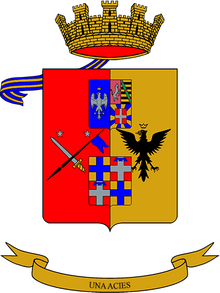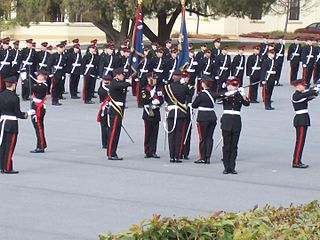
A military academy or service academy is an educational institution which prepares candidates for service in the officer corps. It normally provides education in a military environment, the exact definition depending on the country concerned.
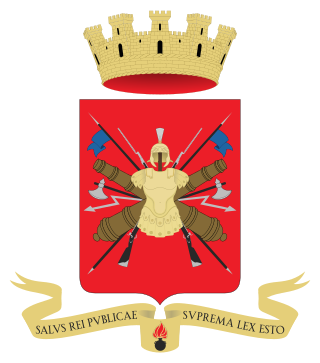
The Italian Army is the land force branch of the Italian Armed Forces. The army's history dates back to the Italian unification in the 1850s and 1860s. The army fought in colonial engagements in China, Libya, Northern Italy against the Austro-Hungarian Empire during World War I, Abyssinia before World War II and in World War II in Albania, Balkans, North Africa, the Soviet Union, and Italy itself. During the Cold War, the army prepared itself to defend against a Warsaw Pact invasion from the east. Since the end of the Cold War, the army has seen extensive peacekeeping service and combat in Afghanistan and Iraq. Its best-known combat vehicles are the Dardo infantry fighting vehicle, the Centauro tank destroyer and the Ariete tank and among its aircraft the Mangusta attack helicopter, recently deployed in UN missions. The headquarters of the Army General Staff are located in Rome opposite the Quirinal Palace, where the president of Italy resides. The army is an all-volunteer force of active-duty personnel.

The Nunziatella Military School of Naples, Italy, founded November 18, 1787 under the name of Royal Military Academy, is the oldest Italian institution of military education among those still operating. Its building, familiarly called "Red Manor", and the adjacent church of the Santissima Annunziata, is an architectural monument of the city of Naples.

The Paratroopers Brigade "Folgore" is an airborne brigade of the Italian Army. Its core units are three battalions of paratroopers (paracadutisti). The name "Folgore" is Italian for lightning. The Folgore is one of three light infantry brigades of the Italian Army. While the Folgore specializes in parachute operations its sister brigade in the Division "Vittorio Veneto" the Airmobile Brigade Friuli specializes in helicopter assault operations. The Folgore and its units are based in Tuscany, Veneto and Lazio.
The Gold Medal of Military Valor is an Italian medal established on 21 May 1793 by King Victor Amadeus III of Sardinia for deeds of outstanding gallantry in war by junior officers and soldiers.
The article provides an overview of the entire chain of command and organization of the Italian Army after the reform of 1 October 2016 and includes all active units as of 1 July 2019. The Armed Forces of Italy are under the command of the Italian Supreme Defense Council, presided over by the President of the Italian Republic. The Italian Army is commanded by the Chief of the Army General Staff or "Capo di Stato Maggiore dell’Esercito" in Rome.
On March 1, 1984 the Italian Institute for Disarmament, Development and Peace (Istituto di ricerche per il disarmo, lo sviluppo e la pace in Rome published the entire Italian Army order of battle down to company level – this was justified by the radical party as one of its core demands was total disarmament of Europe, even though the data which was published was top secret. The Radical Party dissolved in 1989 and the IRDISP followed suit in 1990. But Radio Radicale has survived, and the OrBat can still be found today on the homepage of the radio.

The 1st Infantry Division "Superga" was an infantry division of the Royal Italian Army during World War II. The Superga was classified as a mountain infantry division, which meant that the division's artillery was moved by pack mules instead of the horse-drawn carriages of line infantry divisions. Italy's real mountain warfare divisions were the six alpine divisions manned by Alpini mountain troops. The Superga recruited primarily from central Piedmont and was based, together with its two infantry regiments, in Turin, while the 5th Artillery Regiment was based in Venaria Reale. The division was and named for the Superga hill near Turin, where members of Italy's Royal House of Savoy were buried in the Basilica of Superga.
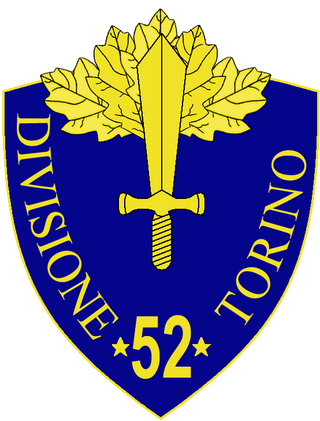
The 52nd Infantry Division "Torino" was an infantry division of the Royal Italian Army during World War II. The Torino was named after the city of Turin and classified as an auto-transportable division, meaning it had some motorized transport, but not enough to move the entire division at once. The division was formed by expanding the Torino Brigade in June 1940 and was based with two of its regiments in Civitavecchia, while the 81st Infantry Regiment "Torino" was based in Rome. The division took part in the Invasion of Yugoslavia and was then sent to the Eastern front as part of the Italian Expeditionary Corps in Russia.

The 37th Infantry Division "Modena" was a infantry division of the Royal Italian Army during World War II. The Modena was classified as a mountain infantry division, which meant that the division's artillery was moved by pack mules instead of the horse-drawn carriages of line infantry divisions. Italy's real mountain warfare divisions were the six alpine divisions manned by Alpini mountain troops. The division was formed on 25 March 1939 with units of the 5th Territorial Division "Imperia" and named for the city of Modena. The division was made up entirely of men from the city of Genoa and the surrounding Liguria region. The division's regimental depots were shared with the 63rd Infantry Division "Cirene", which was based in Benghazi in Libya and recruited its men from and trained them in Liguria.

Spanish military units have coats of arms, badges and emblems to distinguish them from other units both joint Armed Forces and service branches units.

The Motorized Brigade "Cremona" was an infantry brigade of the Italian Army. The brigade's headquarters was in the city of Turin. The brigade carried on the name and traditions of the 44th Infantry Division "Cremona".

The Royal Sardinian Army was the army of the Duchy of Savoy and then of the Kingdom of Sardinia, which was active from 1416 until it became the Royal Italian Army on 4 May 1861.
With the 1975 reforms the Italian Army abolished the regimental level and replaced it with brigades made up of multiple arms. During the reform the army disbanded 48 regimental commands and reduced its force by 87 battalions. A further ten regimental commands were used to raise ten new brigade commands. Ten training centers, which for traditional reasons had carried the names of regiments, were also disbanded. The reduction in units also allowed to mechanize most of the remaining units in Northern Italy and Italy's defense strategy changed from a hold-at-all-costs territorial defense to one of mobile warfare.

The Artillery Command is an Italian Army command, which trains the personnel destined for the army's artillery units, develops the army's artillery doctrine, and supervises the Italian army's artillery units.
Augusto Ugolini was an officer in the Royal Italian Army during World War II, best known for his leadership during the battle of Culqualber, for which he was awarded the Gold Medal of Military Valor.
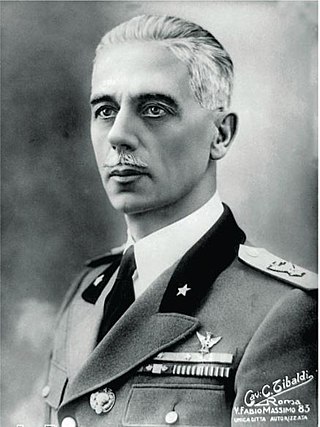
Riccardo Moizo was an Italian aviation pioneer in the early part of the 20th century and a general during World War II. He was Commander-General of the Carabinieri from 1935 to 1940 and the last High Commissioner of the Province of Ljubljana in 1943; from 1939 to 1943 he was also a member of the Italian Senate.

Giuseppe Ottolenghi (1838–1904) was an Italian general and politician.
Alberto Mannerini was an Italian general during World War II. After the war he served as Commander-General of the Carabinieri from 1950 to 1954.

Luigi Nava (1851-1928) was an Italian General of the Army who participated in the First Italo-Ethiopian War and World War I. He participated in the Italian colonial campaign in the Horn of Africa which lead to his participation at the Battle of Adwa, where he was wounded and taken prisoner by the Abyssinians. Having become Lieutenant General, at the action of the general mobilization of 1915 he was appointed commander of the 4th Army but was dismissed from the command four months after Italy entered the war.
